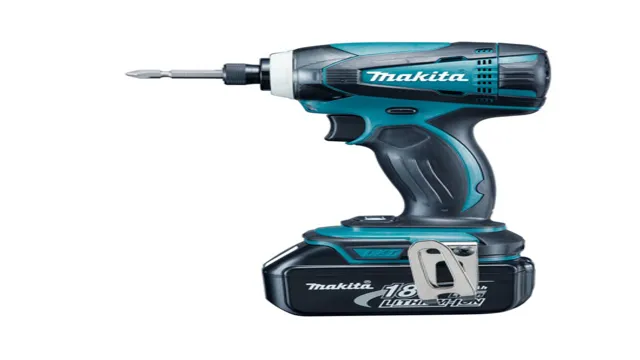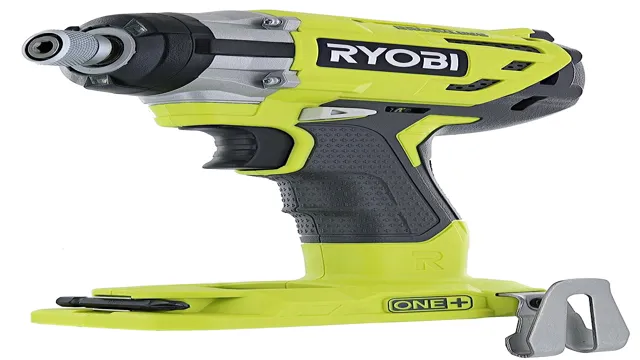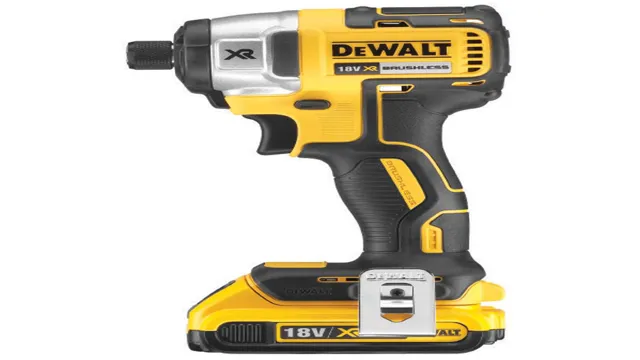Will an Impact Driver Drill into Concrete? Using the Right Tools and Technique to Get the Job Done!

Looking to drill into concrete? You might be wondering if your trusty impact driver is up to the task. The truth is, while an impact driver can certainly be a powerhouse tool, drilling into concrete may require a specialized machine. Impact drivers are designed for fastening screws and bolts, but they may not have the power or the right type of drill bit to penetrate the hard surface of concrete.
That being said, there are certain steps you can take to make the most out of your impact driver and achieve concrete drilling success. So, let’s dive into the world of impact drivers and concrete and see what’s possible!
Understanding Impact Drivers
Impact drivers have become popular among DIY enthusiasts and professionals for their power and efficiency in driving screws and bolts. But many people wonder if they can use an impact driver to drill into concrete. The answer is yes, but with some limitations.
Impact drivers are not designed to drill holes, but rather to drive screws and bolts. However, with the right bit and technique, an impact driver can be used to drill small holes into concrete, masonry, and other hard materials. For larger holes, it is recommended to use a hammer drill.
It is also important to use the right type of bit and to apply enough pressure to avoid any damage to the tool. With these precautions in mind, an impact driver can be a useful tool for drilling into concrete for light-duty tasks.
What is an Impact Driver?
An impact driver is a powerful tool that uses concussive force to drive screws and bolts into hard surfaces quickly and with ease. The high-torque rotational force of the driver means it can complete tasks in less time than a traditional drill and can handle much tougher jobs. Unlike traditional drills, which are designed primarily for drilling holes, impact drivers come equipped with a collet that accepts all types of shank bits.
This makes them incredibly versatile and valuable in a wide range of industries such as construction, carpentry, plumbing, and mechanics. Ultimately, an impact driver is an essential tool in any tradesperson’s arsenal due to its power, speed, and efficiency.

How Do Impact Drivers Work?
Impact drivers are versatile tools that are used by both professionals and DIY enthusiasts alike. The way they work is quite fascinating; they use a combination of rotational force and concussive blows to drive screws into various materials, making them a much more efficient option than other power tools like drills. Essentially, an impact driver works by using a hammering motion to deliver a greater amount of torque than a traditional drill, which makes it easier to drive screws into harder materials like hardwoods or metal.
This is done by using an internal mechanism that generates a sudden burst of rotational force and then quickly stops it, creating a series of impacts that provide the necessary force for screw-driving tasks. In short, impact drivers can make tasks like screw-driving quicker, more efficient, and less demanding on the user while also offering greater precision and control.
Drilling Into Concrete with an Impact Driver
If you’re wondering whether an impact driver can be used to drill into concrete, the answer is yes! Although impact drivers were initially designed to drive screws and bolts into tough materials like wood, they are also capable of drilling into sturdier surfaces like concrete and masonry. This is thanks to their high-torque delivery and rapid rotation. However, it’s important to note that standard impact drivers aren’t as efficient as dedicated rotary hammer drills when it comes to drilling into concrete.
For lighter duty concrete drilling tasks like anchor installation and minor repairs, using an impact driver can get the job done. However, for tougher jobs such as drilling large diameter holes, it’s recommended that you use a rotary hammer drill instead. So, while an impact driver can drill into concrete, knowing its limitations is essential for getting the job done efficiently and safely.
Factors to Consider
When it comes to drilling into concrete with an impact driver, there are several factors to consider before getting started. First and foremost, it’s important to choose the right bit for the job. Look for a carbide-tipped masonry bit that is specifically designed for drilling into concrete.
It’s also important to use proper safety gear, including goggles and ear protection. Before drilling, mark the exact spot where you want to make the hole and make sure that the area is cleared of any debris. When drilling, use a steady pressure and keep the tool at a right angle to the surface.
Don’t force the tool or apply too much pressure, as this can cause the bit to break or damage the concrete. Remember, proper preparation and technique can make all the difference when it comes to drilling into concrete with an impact driver. So, take your time, stay safe, and happy drilling!
Tips and Tricks for Success
If you need to drill into concrete, an impact driver can be a game-changer. It’s a powerful tool that can make the job much easier, but there are a few things you need to keep in mind. First, make sure you have the right bit.
Concrete requires a carbide-tipped drill bit, which is specifically designed to handle the hardness of the material. Second, use the impact setting on your driver. This will create a rapid, hammer-like motion that will break through the concrete more easily.
Third, be patient. It’s important to drill slowly and steadily, allowing the bit to work its way through the concrete. And finally, wear proper safety gear.
Concrete dust can be harmful to your lungs, so make sure you’re wearing a mask and safety goggles. With these tips in mind, you’ll be able to tackle any concrete drilling project with confidence and efficiency.
Examples of Impact Drivers That Can Drill Into Concrete
An impact driver is a powerful tool that can quickly drive screws and bolts into tough materials like concrete. But can it also drill into concrete? The answer is yes, but not all impact drivers are created equal. Some models are designed specifically for drilling into masonry, while others may struggle with the task.
If you’re planning to use your impact driver to drill into concrete, look for models with high levels of torque and hammering action. The DEWALT DCF887B and Makita XDT131 are two examples of impact drivers that can handle drilling into concrete with ease. These models have high torque levels, multiple speed settings, and adjustable hammering action, making them ideal for heavy-duty drilling tasks.
Just be sure to use a masonry bit and follow proper safety precautions, such as wearing eye protection and earmuffs. With the right impact driver, drilling into concrete can be a breeze.
When to Use an Impact Driver for Concrete
Many people are often unsure if an impact driver can drill into concrete, but the answer is yes, it can. However, using an impact driver for concrete jobs is not always the best option, as it can be limited in terms of power and depth compared to dedicated hammer drills. Impact drivers are best for smaller projects such as installing screws or fasteners in concrete walls, while larger projects like drilling deep anchor holes for heavy-duty fixtures would require more powerful tools.
It’s important to consider the intensity and thickness of the concrete you are working with before deciding which tool to use. While an impact driver can be a suitable option for concrete tasks, it may not be the most efficient or effective choice every time.
Alternatives to Consider
When it comes to concrete work, an impact driver can be a useful tool for certain tasks. For instance, impact drivers are excellent for driving large screws and bolts into concrete faster and with less effort than a traditional drill or hammer. However, it’s important to note that impact drivers aren’t always the best option for concrete work.
If you need to drill holes into the concrete, a rotary hammer or hammer drill is the better choice. These tools are designed to handle the density and hardness of concrete, whereas an impact driver may struggle. When deciding whether to use an impact driver for concrete, consider the task at hand and determine if an impact driver is the most suitable option for the job.
Safety Precautions
Impact driver for concrete When it comes to working with concrete, there are different tools that you can use depending on the task. One of these tools is the impact driver, which is specifically designed to drive screws and bolts into hard materials such as concrete. However, it’s important to know when it’s safe to use an impact driver for concrete to avoid injuries and accidents.
Impact drivers are powerful tools that deliver high torque, and they can be dangerous if not used correctly. If you’re working with concrete that is already established and cured, an impact driver can be a good option for driving screws and bolts into the material. On the other hand, if you’re working with fresh concrete, or if you’re drilling holes, you should avoid using an impact driver because it can cause cracking and damage to the concrete.
To ensure safety when using an impact driver for concrete, it’s essential to protect your eyes and ears. Concrete can produce a lot of dust and debris, so wearing a face mask and goggles can help prevent irritation and injury to your eyes and lungs. Additionally, using ear protection can help protect against the loud noise produced by the impact driver.
In conclusion, an impact driver can be a useful tool for driving screws and bolts into established and cured concrete, but it should be avoided when working with fresh concrete or drilling holes. Always take safety precautions to avoid injuries and accidents, including wearing protective gear and using the proper tools for the task at hand.
In Conclusion
In conclusion, using an impact driver to drill into concrete is like trying to use a fork to eat soup – it’s not the right tool for the job. While an impact driver can apply a lot of torque, it’s not designed to handle the hard, dense material of concrete. Instead, opt for a rotary hammer drill or a hammer drill with a masonry bit for a more efficient and effective drilling experience.
“
FAQs
Can an impact driver drill into concrete?
Yes, an impact driver can drill into concrete with the help of masonry bits.
What type of masonry bits should be used with an impact driver for drilling into concrete?
Carbide-tipped masonry bits are the best choice for drilling into concrete with an impact driver.
Will using an impact driver to drill into concrete generate a lot of dust?
Yes, drilling concrete with an impact driver can generate a significant amount of dust. It is recommended to wear a dust mask and eye protection.
Can an impact driver be used to set concrete screws?
Yes, impact drivers can be used to set concrete screws quickly and efficiently.
What is the maximum depth an impact driver can drill into concrete?
The maximum depth an impact driver can drill into concrete depends on the power of the impact driver and the size of the masonry bit. However, it is generally recommended to drill no deeper than 4 inches into concrete with an impact driver.
Can an impact driver be used to remove concrete screws?
Yes, impact drivers can be used to remove concrete screws easily and quickly.
Is it safe to use an impact driver to drill into concrete?
Yes, impact drivers are safe to use for drilling into concrete as long as proper safety precautions are taken, such as wearing personal protective equipment and using the correct masonry bits.



